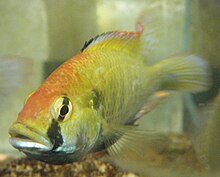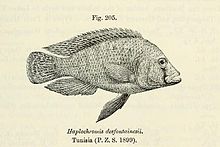Astatotilapia
| Astatotilapia | ||||||||||||
|---|---|---|---|---|---|---|---|---|---|---|---|---|

|
||||||||||||
| Systematics | ||||||||||||
|
||||||||||||
| Scientific name | ||||||||||||
| Astatotilapia | ||||||||||||
| Pellegrin , 1904 |
Astatotilapia is a genus from the cichlid family (Cichlidae), which was established for a species ( Astatotilapia desfontainii ) from oases in North Africa. Their validity and the species to be included are controversial in the literature.
validity
When establishing the genus, Pellegrin had overlooked the fact that a few years earlier Hilgendorf had created a taxonomic unit for fish (namely Haplochromis ), which Astatotilapia also corresponded to. Regan then moved in Astatotilapia . Greenwood revalidated the genus, redefined it and extended it to many more species, although he had to admit here that Astatotilapia does not form a monophyletic unit. Van Oijen summarized the criticism of this and other genera established by Greenwood, which mainly consists of overlapping with newly found species and the impossibility of classifying existing species in one or the other Greenwood genus. Since Astatotilapia has not been redefined since then, the advice is not to use the name for the time being.

features
According to popular belief, " Astatotilapia " species are 9 to 15 cm long, females remain somewhat smaller. In addition, they are usually simply colored, while the males are strikingly colored. The body is of the typical cichlid shape and somewhat flattened on the sides. The head is big and beefy. Astatotilapia differs from the closely related genus Haplochromis by the teeth in the outer rows of teeth, which in Astatotilapia are single-pointed or double-pointed and not compressed or obliquely blunted. The teeth of the inner rows of teeth are small and three-pointed. On the pharyngealia , the middle rows of teeth are covered with enlarged, sometimes molar-like teeth. The caudal fin is rounded. All Astatotilapia species are omnivores and mouthbrooders . They have 3 to 9 egg spots on the anal fin .
- Dandruff formula : mLR 28-30
etymology
Pellegrin, who defines the genus, forms the name from the words Gr .: "astatos" = unstable + tilapia (African cichlid genus). The first part of the name refers to the teeth of the males in the outer rows of teeth, which, like the females, are initially two-pointed, but are replaced by single-pointed ones in the course of the adulthood.
Types and distribution
- Astatotilapia bloyeti (Sauvage, 1883) coastal rivers of Tanzania.
- Astatotilapia burtoni (Günther, 1894) Lake Tanganyika and rivers connected to it ( Lukuga and others)
- Astatotilapia calliptera (Günther, 1894) Lake Malawi , Lake Chiuta , Lake Chilwa , Lower Zambezi , Buzi , Pungwe and Save .
- Astatotilapia desfontainii (Lacepède, 1802) sources in oases in Algeria and Tunisia . ( Type species )
- Astatotilapia flaviijosephi (Lortet, 1883) Jordan , Sea of Galilee .
- Astatotilapia paludinosa Greenwood, 1980 in Lower Malagarasi .
- Astatotilapia stappersii (Poll, 1943) Lake Tanganyika and rivers connected to it.
- Astatotilapia swynnertoni (Boulenger, 1907) Buzi and lower Pungwe , southwards to the Save in Mozambique .
- Astatotilapia tchadensis Trape, 2016 , Lakes of Ounianga in the Sahara.
- Astatotilapia tweddlei Jackson, 1985 Lake Chiuta , Lake Chilwa and incoming rivers.
In Lake Débo in Mali and in the Chad Basin , two further, previously undescribed Astatotilapia species occur.
The following cladogram according to Matschiner et al . shows the position of different Astatotilapia species in the Haplochromini system:
| Haplochromini |
|
||||||||||||||||||||||||||||||||||||||||||||||||||||||||||||
|
|
literature
- Erwin Schraml: Astatotilapia. In: Claus Schaefer, Torsten Schröer (Hrsg.): The large lexicon of aquaristics. Eugen Ulmer, Stuttgart 2004, ISBN 3-8001-7497-9 , pp. 100-102.
- Günther Sterba : The world's freshwater fish. 2nd Edition. Urania, Leipzig / Jena / Berlin 1990, ISBN 3-332-00109-4 .
Individual evidence
- ^ Pellegrin, J. (1904): Contribution à l'étude anatomique, biologique et taxinomique des poissons de la famille des Cichlidés. Memoires Societe Zoologique de France , 16 (2-4): 41-400.
- ↑ Hilgendorf, FM (1888): Fish from Victoria-Nyanza (Ukerewe-See), collected by the late Dr. GA Fischer. Meeting reports of the Society of Friends of Natural Sciences in Berlin , 1888: 75-79.
- ^ Regan, CT (1922): The classification of the fishes of the family Cichlidae. II. On African and Syrian generally not restricted to the great lakes. Annals and Magazine of Natural History , (9) 10 (57): 249-264.
- ↑ Greenwood, PH (1979): Towards a phyletic classification of the `genus' Haplochromis (Pisces, Cichlidae) and related taxa. Part 1. Bulletin of the British Museum (Natural History) Zoology , 35 (4): 265-322.
- ^ Van Oijen, MJP (1996): The generic classification of the haplochromine cichlids of Lake Victoria, East Africa. Zoological negotiations, Nationaal Natuurhistorisch Museum, Leiden , 302: 57-110.
- ↑ a b Sébastien Trape: A new cichlid fish in the Sahara: The Ounianga Serir lakes (Chad), a biodiversity hotspot in the desert. Comptes Rendus Biologies, October 2016, doi: 10.1016 / j.crvi.2016.08.003
- ↑ Matschiner, M., Musilová, Z., Barth, JMI, Starostová, Z., Salzburger, W., Steel, M. & Bouckaert, R. (2017): Bayesian Phylogenetic Estimation of Clade Ages Supports Trans-Atlantic Dispersal of Cichlid Fishes. Systematic Biology, 66 (1): 3-22. DOI: 10.1093 / sysbio / syw076 , pages 176-177 in the supplement.
Web links
- Astatotilapia on Fishbase.org (English)


